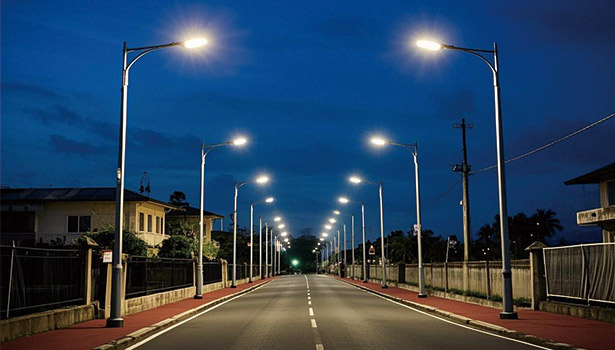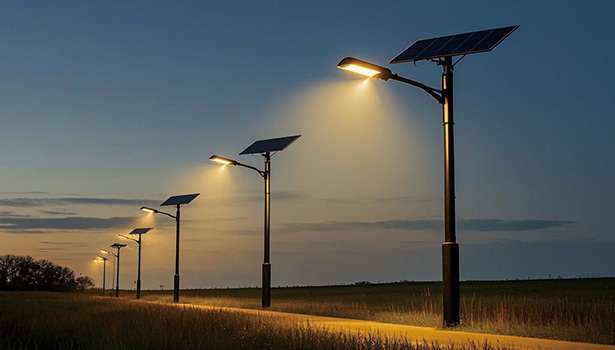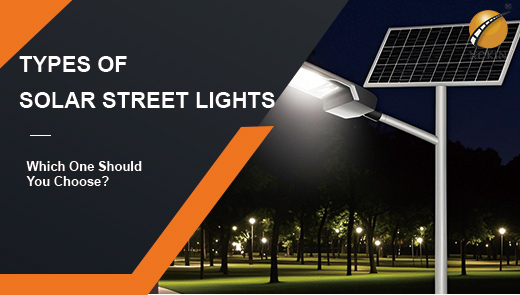Solar VS Traditional street lights: A Comparative Analysis
Street lighting plays an important role in both urban and rural areas. It not only provides safety for pedestrians and vehicles, but also enhances the sense of security and quality of life in the community. In recent years, solar street lightshave received more and more attention as an alternative to traditional street lighting systems. So, exactly which lighting option is more appropriate in different scenarios? Next, let's delve into the various aspects of solar street lights versus traditional streetlights.
Understanding Solar street lights
Key Components
The operation of a solar street light relies on several key components. At the center of this is the solar panel, which consists of highly efficient photovoltaic cells that are responsible for capturing sunlight during the day and converting it into electricity. Common types of photovoltaic cells on the market today are monocrystalline, polycrystalline and amorphous silicon, with different types varying in conversion efficiency and cost.

Charge controllers, on the other hand, play a role in regulating the current and voltage, which ensures that the electricity generated by the solar panels is stably stored in the batteries, while preventing the batteries from being overcharged and prolonging their service life.
Battery cells are usually deep-cycle batteries, such as lead-acid or lithium batteries. These batteries are capable of storing the electricity generated by the solar panels during the day and providing stable power support for the street lights at night. Their storage capacity determines the length of time the street lightcan continue to illuminate at night.
LED lamps are the light source of solar street lights, which are energy efficient compared to traditional lamps, and their brightness can be customized according to actual needs. In addition, some solar street lights are equipped with motion sensors that automatically increase brightness when they detect people or vehicles passing by, and decrease brightness when no one is around, thus further saving energy.
The structure of the bracket on which the street lightis mounted should not be overlooked, as it is designed to ensure that the solar panels are able to obtain the best angle of sunlight, while at the same time guaranteeing the stability and durability of the street lightas a whole.
Working Principle
Solar street lightsfollow a simple and efficient day/night cycle. During the day, the solar panel absorbs sunlight and converts it into electricity, which is stored in the battery through the charge controller. When night falls and the light fades, a photocell sensor on the street lightdetects the change in ambient brightness and triggers a circuit that causes the electricity in the battery to drive LED fixtures that illuminate the street.
Explore Traditional Street Lighting Systems
Common Types
High Pressure Sodium (HPS) is the most common type of traditional street light. It emits a distinctive orange-yellow light, has an average lifespan of about 24,000 hours, and has an energy efficiency of between 100 - 150 lumens per watt. However, its color rendering is relatively poor, making it difficult to accurately render the true color of objects in this light.
Metal halide lamps produce a brighter white light, with an average life of 15,000 - 20,000 hours and an energy efficiency of 75 - 100 lumens per watt. Compared to high-pressure sodium lamps, they offer a significant improvement in color rendering, providing a truer representation of an object's color.

System Components and Operation
A traditional street lightsystem consists of several components. The lamp housing protects the bulb and other electrical components inside; an electronic ballast stabilizes the current and ensures that the bulb works properly; a photocell sensor, similar to that of a solar street light, is used to automatically turn the street lighton at dusk and off at dawn; a control unit manages the overall operation of the street light; and a wiring connection connects the individual street lights to the central power grid, which provides the street lights with electricity.
Conventional street lights are powered by a centralized grid, which requires the laying of a large number of underground cables. In the event of a grid failure, such as an outage due to bad weather, technical problems or maintenance requirements, the street lights are plunged into darkness, affecting road safety and the lives of residents. Although some modern conventional street lights also utilize LED technology, they are still dependent on the grid for power.
Cost Comparison
Traditional street lights
Traditional street lights are more expensive to install because of the extensive wiring and electrical work required. Not only does this work require specialized technicians, but it can also involve digging up pavements, laying cables, and other works, which can be labor-intensive and costly.
In the course of use, the cost of electricity will also escalate as energy prices fluctuate. Moreover, traditional street lamps require regular maintenance, including the replacement of aged light bulbs, repair of faulty electrical components, etc. Such maintenance work will also incur considerable costs. For example, the installation cost of a traditional street light is around US$1,200, and over a 10-year life cycle, with electricity, maintenance and other hidden costs, the total cost could be over US$4,000.
Solar street lights
The upfront investment for solar street lights is relatively high, mainly because of the cost of solar panels, batteries, and other components. However, this is a one-time investment, and in subsequent use, since it utilizes solar power to generate electricity, there is no need to pay for electricity, which greatly reduces long-term costs.
In addition, the installation process of solar street lightsis relatively simple, without the need for complex wiring work, which not only saves installation time, but also reduces installation costs. Furthermore, solar panels and LED luminaires require low maintenance, usually only occasional cleaning and relatively few battery replacements. For the same 10-year life cycle, the upfront investment for a solar street lightmight be around $1,500, with lower subsequent costs totaling about $2,000. In the long run, solar street lights are not only more environmentally friendly, but also more economically advantageous. At the same time, solar street lights embody the concept of sustainable development, and their components, such as batteries and LED lamps, are often recyclable, helping to realize a circular economy and reduce waste.

Installation and Maintenance Comparison
Traditional street lights
The installation process for traditional street lights is complex and disruptive. Due to the need to lay underground cables, there is often some disruption to roads and the surrounding environment, affecting traffic and residents' lives. Moreover, the installation work requires professional electrical engineers and construction teams, which is costly.
Once a street light fails, the maintenance process is equally complicated. Maintenance personnel need to troubleshoot cable failures, replace damaged bulbs and electrical components, etc., which is not only time-consuming, but also may again have an impact on the road and the surrounding environment.
Solar street lights
The installation of solar street light is extremely easy, only need to install the street light in a suitable location and connect the power supply. There is no need to dig up the road surface to lay cables, greatly reducing the installation time and cost, and minimizing the impact on the surrounding environment.
In terms of maintenance, solar street lights reduce many potential points of failure due to the lack of complex wiring and reliance on the power grid. Daily maintenance is mainly a matter of cleaning the solar panels on a regular basis to ensure that they are able to absorb sunlight efficiently, as well as replacing the batteries when they reach the end of their lifespan, making maintenance easy and simple. It can be said that traditional street lights are like a “demanding friend”that requires constant attention and frequent care, while solar street lights are the effortless “easy-going friend”that quietly performs its lighting duties without adding to the trouble.
Reliability Comparison
Traditional street lights
Traditional street lightsare completely dependent on the power grid for power supply, and once problems occur in the grid, such as experiencing bad weather leading to line failure, equipment aging triggered by power outages or grid maintenance, the street lightswill lose their lighting function, plunging the streets into darkness. This will not only bring safety hazards to pedestrians and vehicles, but also may affect the normal order of life in the community.

Solar Powered street lights
Solar street lights have built-in batteries, and the solar panels store electricity in the batteries during the day, so even if the power grid fails, the street lights can still rely on the electricity in the batteries to continue to work. This feature allows solar street lights to perform well in areas with frequent power outages or poor grid infrastructure, providing consistent and reliable lighting. Figuratively speaking, the traditional street light is like a friend who always forgets to charge his cell phone and drops the chain at critical moments, while the solar street light is like a friend who carries a rechargeable battery with him at all times and is always prepared.
Technology Comparison
Energy Source
Solar street lightsuse renewable solar energy as energy source, which is inexhaustible and does not produce any pollutants in the process of using. Traditional street lights rely on grid power, which often includes fossil fuels such as coal, emitting large amounts of greenhouse gases and polluting the environment in the process of generating electricity. Solar street lights convert sunlight into electricity through their own solar panels, realizing autonomous power supply without relying on the external power grid.
Energy Consumption and Efficiency
In terms of energy consumption, there are obvious differences between solar street lightsand traditional street lights. Solar street lights are designed to focus on the efficient use of energy, and their LED lamps consume less energy. In contrast, traditional street lights, especially high pressure sodium and metal halide lamps, consume more energy.
In terms of luminous efficacy, LED luminaires are used in both solar street lights and some traditional street lights using LED technology. However, because the system design of solar street lights focuses more on energy saving, their LED luminaires perform better in terms of lifetime and energy saving. For example, LED luminaires in solar street lights typically last longer than their counterparts in conventional street lights, providing consistent illumination while reducing energy consumption.

Environmental Impact Comparison
Carbon Footprint
Solar street lights produce virtually no greenhouse gas emissions during operation, greatly reducing their negative impact on the environment. By utilizing clean solar energy, it avoids the large amount of carbon emissions generated by traditional street lights that rely on the power grid (especially thermal power). Traditional street lights have a negative impact on global climate change due to their reliance on grid power, where thermal power generation releases large amounts of carbon dioxide and other greenhouse gases.
Energy Sustainability
The use of solar street lights helps to achieve energy self-sufficiency and reduce reliance on the traditional power grid, especially during peak electricity consumption periods, which can effectively reduce the load pressure on the grid. This is of great significance to the sustainable development of energy and rational utilization of resources. Through the promotion of solar street lights, it can reduce the demand for limited fossil energy and promote the optimization of energy structure.
Waste and Resource Utilization
Some materials used in the production process of traditional street lamps, such as mercury in high-pressure sodium lamps, may cause harm to the environment. And after scrapping, improper handling of these materials can also pollute soil and water. Solar panels and batteries of solar street lightsneed to be properly disposed of after scrapping to avoid pollution to the environment. At present, many regions have begun to pay attention to the recycling of solar panels and batteries. Through the professional recycling process, the valuable materials can be extracted from them, so as to realize the reuse of resources and reduce the generation of waste.
Installation vs. Infrastructure Requirements
Solar Street Light
The installation of solar street lightsrequires the selection of sunny locations to ensure that the solar panels can fully absorb sunlight. Its installation process is characterized by modularity and flexibility, and does not require large-scale modification of existing infrastructure. This characteristic makes solar street lightsparticularly suitable for use in off-grid areas, remote villages or areas that are difficult to connect to the power grid. In these areas, the installation of solar street lights can quickly solve lighting problems without the need to invest large sums of money in the construction of grid infrastructure.
Traditional street lights
The installation of traditional street lights requires a large upfront investment in building grid infrastructure and laying cables. Especially in rural or developing areas, it is extremely costly to extend the grid to remote areas. Moreover, as cities grow and the demand for street lights increases, the expansion and upgrading of traditional street lighting systems also requires significant investment, which can be a heavy burden for some financially constrained areas.
Social and Economic Impact
Advantages for off-grid areas
Solar street lighting offers significant advantages in rural, off-grid or urban areas with poor infrastructure. It can provide reliable lighting in these areas without the need for costly grid extensions. Good lighting conditions can enhance local residents' sense of security, promote nighttime activities, improve the overall quality of life in the community, and contribute positively to local social development.
Job creation and local economy
The promotion and application of solar street lights can drive employment growth in the solar energy and installation industries, providing more job opportunities for local residents. The entire industrial chain, from the production of solar panels and the assembly of street lights to installation and maintenance, requires manpower support. In contrast, although traditional street light systems have a more mature supply chain, their contribution to local economic development is relatively weak in off-grid areas, as their installation and maintenance are often concentrated in the hands of a small number of professionals, with little effect on driving local employment.

Challenges and Limitations
Solar street lights
One of the main challenges of solar street lights is the high upfront investment, which may be unaffordable for some projects or regions with limited budgets. Financing difficulties may also be a hindrance, especially when installing solar street lights on a large scale. In addition, the performance of solar street lights is highly affected by geographical and climatic conditions. In areas with insufficient sunlight, such as those with prolonged cloudy or rainy conditions, the amount of power generated by solar panels will be affected, which in turn will affect the lighting effect of the street lights. Although advances in battery technology have alleviated this problem to a certain extent, it is still a limiting factor in the development of solar street lights.
Traditional street lights
Traditional street lights face serious environmental and sustainability issues. Their reliance on non-renewable energy sources not only exacerbates the energy crisis, but also has a negative impact on the environment. Moreover, in the long run, traditional street lights have high operation and maintenance costs, which will increase further as energy prices rise and equipment ages.
In summary, there are significant differences between solar street lights and traditional street lights in a number of ways. Solar street lights excel in terms of long-term cost, ease of installation and maintenance, reliability, environmental protection and applicability to off-grid areas. However, their higher upfront investment and dependence on geographical and climatic conditions cannot be ignored. Although traditional street lights have relatively low upfront investment, they have significant disadvantages in terms of operating costs, environmental impact and dependence on the grid.
When choosing a street lighting system, comprehensive consideration should be given to specific scenarios. For areas with limited budgets and good grid infrastructure, traditional street lights may be an option. However, for areas that are environmentally conscious, want to reduce long-term costs, have off-grid needs or have unstable power grids, solar street lights are undoubtedly a better choice. With the continuous progress of technology and further cost reduction, solar street lights are expected to play a more important role in the future of street lighting and deserve more research and promotion.




